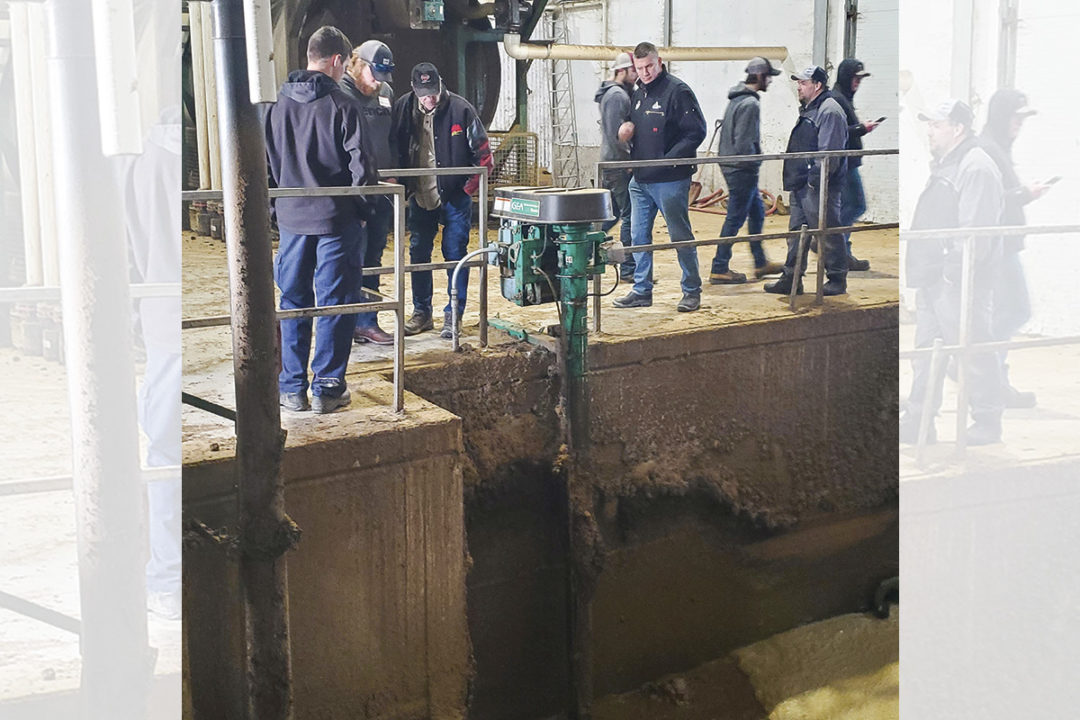To read this article in French, Click here.
Now more than ever, manure management is critical for successful farming. Last year, Canada’s government set a target to reduce nitrogen emissions by 30%, and improving manure management will be necessary to reach that goal. Building on a three-part video series on manure innovation, a manure tour went across Ontario and talked with 250 farmers about manure management and innovation. The events were funded by the Ontario Ministry of Agriculture, Food and Rural Affairs (OMAFRA), coordinated by Farm & Food Care Ontario and delivered by the Ontario Professional Agri-Contractors Association (OPACA).
Manure management starts in the barn
There is not a silver bullet to managing manure, but incremental improvements can be made across the system, starting with feed and bedding. Feed rations impact more than milk production; they will also change nutrient values in manure, so it is always a good idea to test manure after a change in feed. Bedding also has a huge impact, both on the nutrient value and consistency of manure. In eastern Ontario, dairy farmers use a lot of straw bedding, while in western Ontario, they prefer sand bedding, which has no nutrient value but takes manure solids to the bottom of the pit with it.
What about no bedding in the manure? On the tour, participants visited Stonecreek Farms of Woodham and were able to see their composter and bedding recovery system. After going through the press to remove solids, the remaining liquid manure is much easier to handle. The family has installed pipes underground to pump their manure to the fields.
Sustain nutrient content with proper storage
As manure gets into storage, it is still at its peak value in terms of nutrients. It was estimated that a 160-foot manure pit that is 14 feet deep holds 2 million gallons of manure and a composition nutrient diagnosis of at least $100,000 worth of nitrogen, phosphorus and potassium (NPK). However, manure is biological and begins to change immediately, depending on whether it has oxygen or not. Without oxygen, like most liquid manure pits, the storage begins to produce methane (CH4) and ammonia (NH3), among other gases. The hotter it gets, the faster it off-gases carbon and nitrogen. Research is showing that the higher the pH, the faster gases leave and the faster nutrients are lost.
Covering a storage pit not only keeps rainwater out of the manure and increases the nutrient concentration, but it can keep it cooler. There are a few options for both permeable and impermeable covers that can minimize off-gassing, but the easiest is to blow straw on top of the pit. In the case of eastern Ontario, the thick crust from straw bedding is surely reducing nutrient losses.
Manure additives may be promising, but there is more research needed on which ones work best. Dr. Andrew VanderZaag, a researcher from Agriculture and Agri-Food Canada, has had success in trials to reduce the pH and off-gassing using sulphuric acid. Dr. Claudia Wagner-Riddle with the University of Guelph has also found that emptying a manure pit completely can disrupt microbial growth. Emptying a pit before the weather turns hot reduces methane production by 25%, and the more frequent the emptying, the better. This is great news for dairy farmers that spread after each cut of hay.
Some farmers are capturing the methane from anaerobic conditions for natural gas, but other farmers are creating aerobic conditions in their storages. The tour stopped at Sigview Farms of Moorefield, where Simon and Kristina Signer designed their new dairy barn with a compost bedding pack that is aerated daily. At the headrails, manure is stored and aerated intermittently under the slatted floor. In aerobic conditions, methane and hydrogen sulphide are not produced, and the air quality in the barn is improved.
Apply at the right time, rate or not at all
Despite all the best ways to preserve nutrients during storage, all of this can be wasted if the manure is applied at the wrong rate, time or place. On hot and windy days, nitrogen blows away in ammonia form, especially if not incorporated right away. In cold, wet conditions, it leaches away in nitrate form or is lost as nitrous oxide to the air. Similarly, the phosphorus in manure is lost through water movement in or on the soil.
When is the best time to apply manure to make the most of the nutrients? That depends on both the manure and the crop. The nitrogen in dairy digestate is fast-release and is best used in a living crop that can uptake it immediately. Farmers have success drag-lining liquid manure into standing corn or broadcasting onto a cover crop. Applying on hay ground is already a common practice for dairy farmers.
Nutrients can also be lost when broadcasting manure at high pressure. Injecting manure is a great way to keep both nutrients and the soil structure intact. An alternative to injection is a dribble bar that applies liquid manure at low pressures right at ground level. The value of manure also depends on whether the soil needs it. Soil sampling is important, and there is the technology for variable-rate manure application.
Manure is a critical part of a healthy soil and does well in a system that supports soil health. Adrian Güntensperger is a dairy farmer near Seaforth, a custom manure applicator and vice president of OPACA. Soil health is about minimizing tillage, and his goal is to band manure in a strip-till system. He also reduces compaction by staying off wet fields in the spring, controlling traffic on the field and running on low tire pressures, using an on-the-go inflation/deflation technology.
When soil nutrient levels are adequate, the best value to a farmer would be to sell or trade the manure off the farm. Several farmers on the tour bought or sold manure, but it was difficult to decide on a price because it is a market that is more driven by supply and demand, and it varies by region. The main issue with manure is its bulkiness, and that makes it expensive to transport far. Manure dewatering for further transport seems easy enough, but phosphorus ends up with the liquids, potash with the solids and nitrogen splits between the two, so there are still costs associated with handling both.
There is no catch-all solution to manure management, but there are several ways farmers can improve their systems by paying attention to feed, bedding, storage, application timing, rates and placement, soil health, and by frequently testing soil and manure nutrient levels. By making more efficient use of nutrients in manure, farmers reduce their nitrogen and greenhouse gas emissions, and they can also save big money on fertilizer.
The manure innovation videos and recording of the online stop of the manure tour are available online.









